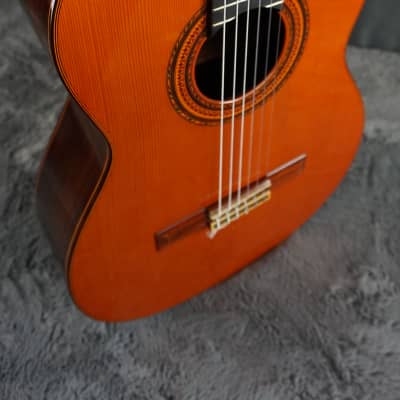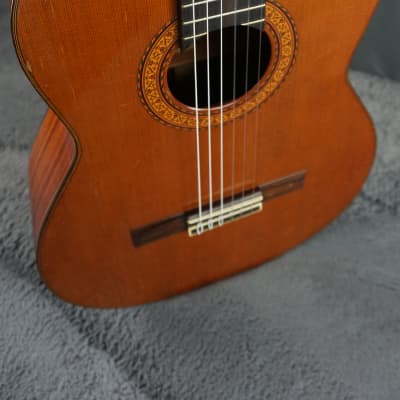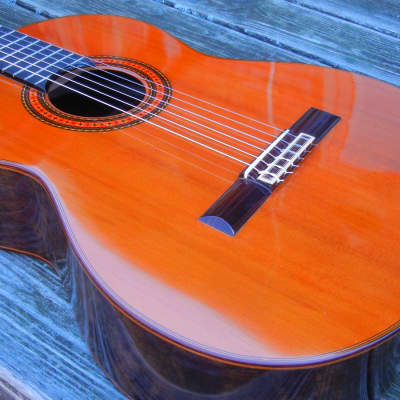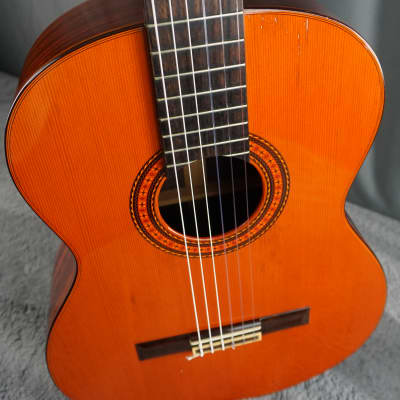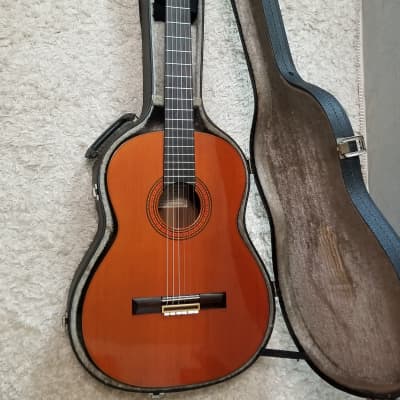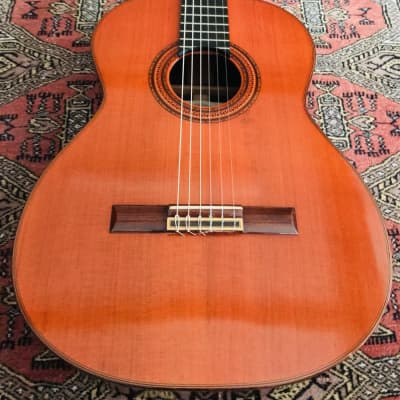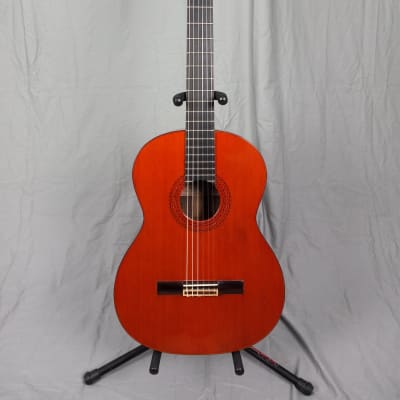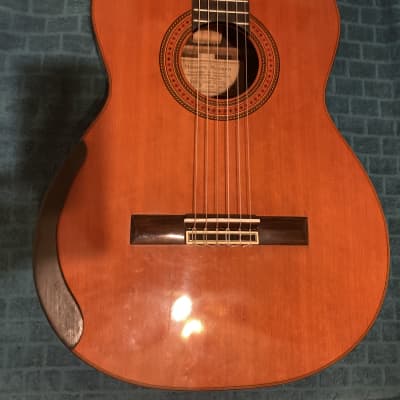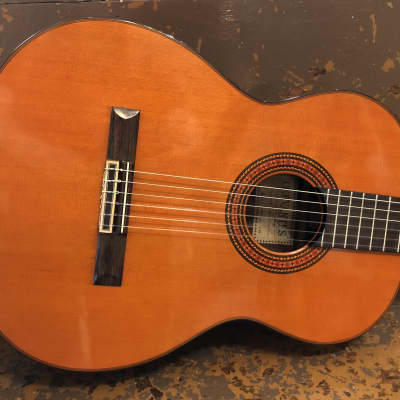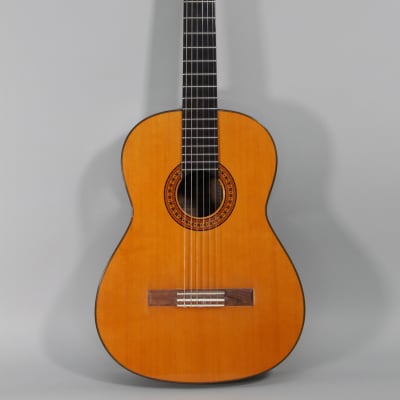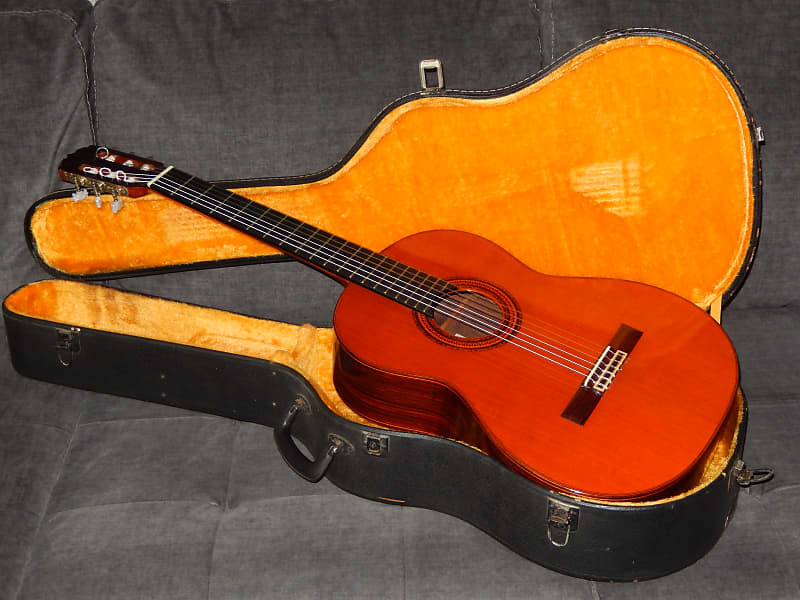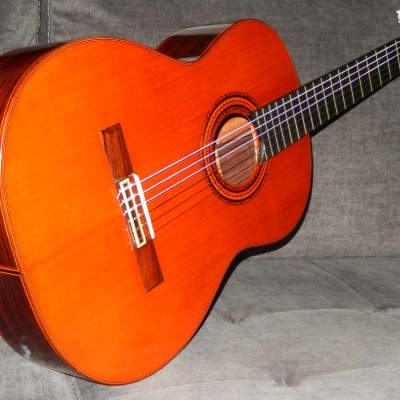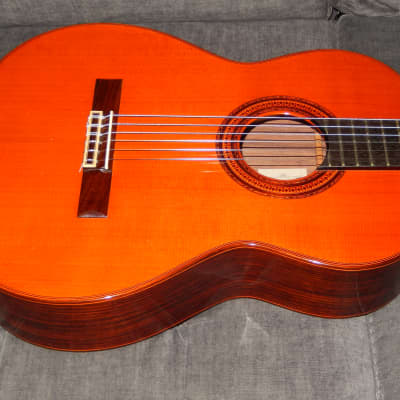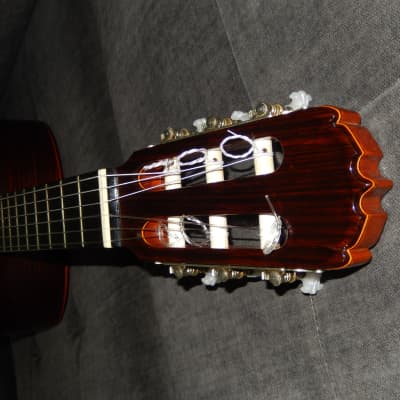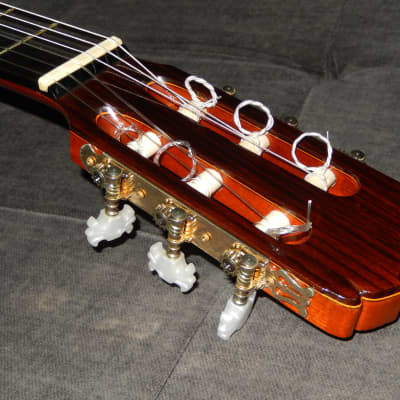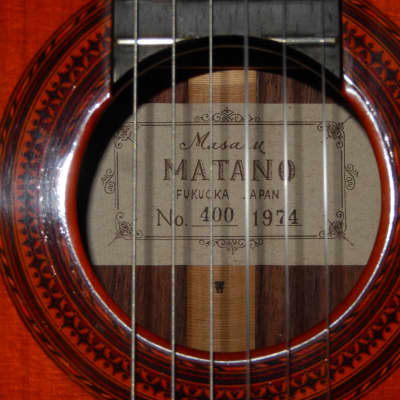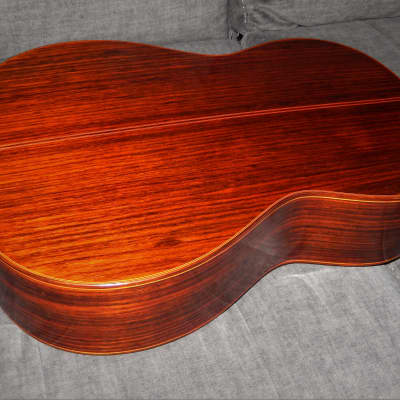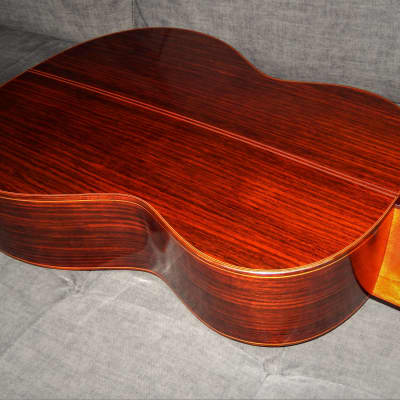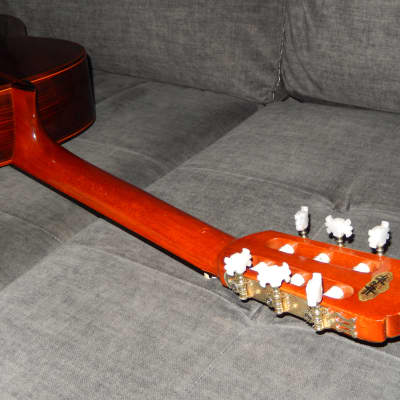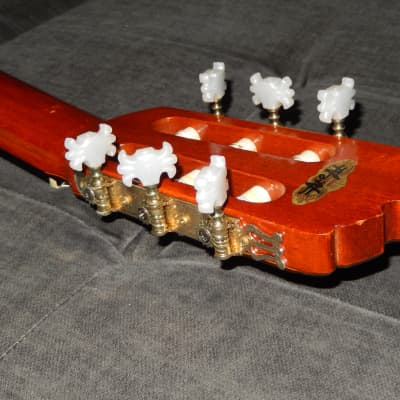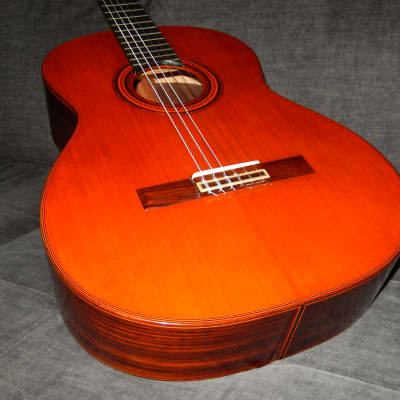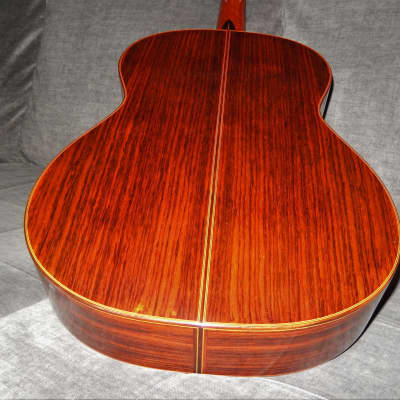Masaru Matano Grand Concert Guitar Classe 400 made in 1974
This
absolutely wonderful guitar, was made in 1974 at Masaru Matano’s workshop in Fukuoka,
Japan.
This
is not a copy of Ramirez guitars. It is greatly improved Ramirez guitar.
To
learn more about Masaru Matano and his achievements you may need to read next
chapter titled: "Asturias Story" located below this posting.
While evaluating true value of Japanese made
vintage guitars it is very important to understand that due to rapid inflation
in early/mid 1970s Japan, constantly increasing cost of labor and cost of
imported materials, labeling of guitar models was being changed frequently in
connection with their higher prices. Model 500 made in 1975 it is not of the same
grade as model 500 from 1974 or model 500 from 1973. In fact, model 400 from 1973
(priced 40 000 yen) would be labelled as 500 in 1974 (priced 50 000
yen) and labelled as 600 in 1975 (priced 60 000 yen). In later years,
certain models were made “for less” while their price remained the same.
Therefore, model 600 from 1978 is no match to model 600 from 1975, or model 500
from 1974, or model 400 from 1973. I hope it is all not that super complicated
to grasp.
This
guitar was priced 40 000 yen in 1974, while yearly salary of Japanese college
graduate was around 70 000 yen. If compared with many other Japanese made
guitars from that era, this guitar was absolutely underpriced.
In
1975, precisely the same construction & grade guitar would be labelled as
Classe 500. In 1976 it would be labelled as Classe 600.
This
guitar not only rivals much higher priced Masaru Kohno models, but also every
Ramirez guitar you can imagine. To recognize true value of this guitar, first
you need to try all $8000+ “hand made in Spain” guitars available in your area,
before playing this Matano’s masterpiece. This may very well be your “life
changing” experience.
This
guitar absolutely deserves to be called a “Grand Master Concert Guitar”. It is
very light, has incredible volume and is super responsive. Its tonality is
simply breathtaking. The bounty of its overtones and sustain are exceptional.
Despite its very high volume its note clarity and separation are simply superb.
All
luthiers and only very experienced players know how difficult it is to create
an instrument that offers all these mentioned above sound properties. In the
“regular world” the higher the volume of the guitar the lower its note clarity,
separation and overall tonality. Masaru Matano however wasn’t a “regular”
luthier. He was called “the Genius of the Sound” for a good reason.
The
construction of this guitar is based on Jose Ramirez blueprints and enhanced by
Matano’s 7th sense. During 1960s and early 1970s Jose Ramirez
was making the same construction guitars and selling them at the prices equal
to $10000 today. Many Japanese luthiers were using the same blueprint. This
construction greatly reduces the effect of damping of the sound by player’s
body. The sound of such guitars is ultra-rich and “amplified” at the same time.
Despite
its age this Classe 400 guitar remains in excellent overall condition. There are
several tiny dents and just few light scratches on the body of this guitar,
none of them easily visible. There are also few minor indentations of the back
of the neck. Despite all these imperfections, guitar seems to be barely used.
SPECIFICATIONS:
Top: High Grade Solid Cedar/lacquer
The soundboard of this guitar is thin that you may see and
almost touch its braces. It is so sensitive that if you drop a rice grain on it
you will hear a decent “rumble”.
Back
& Sides: Indian Rosewood “laminates”
“Laminated” is
quite unfortunate term regarding Japanese made guitars. These
"laminates" were made from 2 layers of solid wood glued together with
natural resins. They were made so well that they performed as good as solid
woods while being far less expensive in guitar production and far more
resistant to cracking in regular use.Neck: Mahogany
Fingerboard: Very Well Ebonized Rosewood
Masaru Matano’s Rosewood fingerboards are darkened and so
hardened and smoothed, that offer the same looks and feel as Ebony ones
With at the nut: 51 mm
Scale: 658 mm
Action is set to 3.5 mm under E6 and 3.00 mm under E1 with still
some of extra room on the saddle.
This guitar will be shipped in used
hard case in still good condition.
“Asturias Story”
Asturias guitars have always had a great international reputation
for tone and built quality. Asturias guitars are still made at the same small
workshop located in Kurume, Japan. This workshop employs about 10 highly
skilled craftsmen, each of them capable making a guitar on his/her own. Since
1981 Asturias workshop is led by master luthier Wataru Tsuiji
This workshop in Kurume began making guitars in 1962, under the
name Meiko Gakki co. and ownership of Masaru Matano. Masaru Matano was Japanese
luthier legend, until today remembered in Japan as “the genius of sound”. He
earned this title before 1962, after improving the sound of many old violins,
including famous Stradivarius violins.
Meiko Gakki workshop was making classical guitars in rather
limited numbers, with emphasis placed on quality. Initially these guitars were
sold under the Meiko Gakki label and just signed by Matano. Sometime in 1968
the labels were changed to Masaru Matano “Costructor de Guitarras” (and Meiko
Gakki was placed below Matano’s name). Sometime in 1974 “Meiko Gakki”
disappeared from the labels. During years 1974-1975 Masaru Matano introduced
yet another series of guitars with their own unique design labels that had just
Masaru Matano name on them and were marked as made in Fukuoka, Japan. This
means that Kurume workshop wasn’t the only one Matano owned at that time. Well
that is not all. During the same years 1974-1975 Masaru Matano with another
group of associates was making wonderful La Esperanza guitars marked as made by
Ongaku Geijutsusha Co. While most of Masaru Matano - Meiko gakki guitars had
Cedar tops and Matano’s unique design headstocks, La Esperanza guitars had
mostly Spruce tops and Ramirez style headstocks. La Esperanza guitars had
exactly the same style labels as those used on Matano – Meiko Gakki guitars.
While great majority of Matano’s own label guitars were not signed by him or
anybody else, La Esperanza guitars had labels signed by their actual makers.
Esperanzas made by Matano himself have his signature their labels. It is quite
likely that La Esperanza guitars were made at Matano’s Fukuoka
workshop.
It is not a secret that (just like most other luthiers in the
world) Matano always had a team of highly skilled associates. One of them was
Tatsuo Tanaka. In late 1960s, Tatsuo was the only Matano’s associate, who could
put his name on Meiko Gakki label. Tatsuo Tanaka could have been Matano’s
partner at that time, but this is not confirmed by any published records. Also,
there are no written records revealing the names of other Matano’s associates.
It is very possible that Hiroumi Yamaguchi and Eichi Kodaira were among
these associates. Both these luthiers started their own workshops in early
1970s and prospered well on their own, but joined “New” Asturias team in 1980.
In 1980 Matano’s Kurume workshop was taken over by Rokkomann Co (Japanese
leading lumber importer) and “New” Asturias workshop came into life. The
details of this transaction are totally unclear and Matano’s disappearance in
1981 never explained to the public. Since 1981 Asturias workshop is led by
Wataru Tsuji, a younger luthier who started to work for Masaru Matano in 1977.
In 1981 “New” Asturias workshop started to use serial number
system on their labels. The design of Asturias labels (unchanged until today)
was created sometime in mid1970s and used on some Masaru Matano’s guitars,
while other guitars still had “Masaru Matano - Meiko Gakki” labels. Some of
these earlier Asturias labels were printed as “Asturias by Masaru Matano”. Very
few of these early (before 1980) Asturias guitars were ever signed by Masaru
Matano.
Hiromi Yamaguchi’s name for the first time appeared on guitar
labels in early 1970s. Yamaguchi established his own brand: “Cervantes”
Concierto Guitarras. His Cervantes guitars, not only looked like Masaru Matano
-Meiko Gakki ones, but were made exactly the same way, and sounded as great as
Matano’s creations. The only difference were headstock designs. After Yamaguchi
joined “New” Asturias team in 1980, he (or just his workshop) was still making
Cervantes guitars. Cervantes guitars were made until 1982. In the same year
1982 Hiroumi left Asturias team and started building guitars under his own
name. Hiroumi retired sometime in early 1990s. Eichi Kodaira, since
early 1970s was making 2 lines of guitars, one with his own name on the labels
and second labelled as Ecole Guitarras. Ecole guitars had more ornamental
extras and were considered as more luxurious brand. Within “New” Asturias team,
Eichi Kodaira was responsible for making all AST models. Sometime in 1983-1984
Eichi and a group of his closest associates moved to another workshop located
in Suwa (Nagano Prefecture) and started making Asturias Kodaira guitars,
identical with AST models earlier made at Kurume workshop. Yet few years later,
Eichi stopped making Asturias/Kodaira guitars and continued making AST models
just as Kodaira guitars. His workshop operates until today with only 3
employees: Eichi’s son and 2 other Kodaira family members.
All guitars made by these Asturias associated luthiers are very
high grade, well regarded by a lot of international players who consider them
as the best mid-price range classical concert guitars. It is also very
important to tell you, that guitars made by these makers have always been very
moderately priced if compared to similar grade guitars made by Masaru Kohno or
other Japanese Elite luthiers. During 1970s until 1980 Masaru Matano’s top
model was Classe 1000 (priced 100 000 yen). This model was the only “all solid
woods” one in Matano’s lineup. This guitar however could easily compete with
Masaru Kohno #20 from the same year. Until 1982 top Cervantes, La
Esperanza and Ecole models were also priced 100 000 yen.
Real Value of Japanese Vintage Guitars
The key to understand
value of vintage Japanese guitars is to acknowledge galloping devaluation of
Japanese yen in 1960s & 1970s. This devaluation was somewhat slower in
1980s. The best measure of this devaluation is Starting Yearly Salary of
Japanese College Graduate (SYSJCG).
SYSJCG in 1965 was 19
600 yen, in 1969 – 34 600 yen, in 1970 39 200 yen, in 1972 – 62 300 yen, in
1975 79 200 yen, in 1977 86 200 and in 1980 - 100 000 yen.
During 1960s and most
of 1970s model numbers of Japanese guitars were strictly interconnected with their
prices in Japanese yen. In late 1970s and during following decades model
numbers were no longer strictly associated with their prices. Many Japanese
guitar makers introduced model names instead of model numbers. Others were
still using model numbers with addition of letter abbreviations or other
symbols.
The best and only
logical approach while evaluating real value (real grade) of vintage Japanese
guitar is to compare its price in Japanese yen with SYSJCG during the year
guitar was made.
Any guitar priced 100
000 in 1970 (labelled usually as No10) would be priced 200 000 yen in 1975
(relabeled to No20 or 2000), 300 000 yen in 1977 (labelled as No3, No30 or
3000). Starting in 1977 Masaru Kohno introduced his new models No40 priced 400
000 yen and No50 priced 500 000 yen. By 1984 Kohno started using model names
instead numbers and was raising their prices as he was pleased. Model 50 became
model “Maestro”, model 40 became model “Special”, model 30 became model
“Professional-J”. Naturally other Master luthiers were doing the same
name/price changes.
Knowing all of that,
you can bet on that Masaru Kohno No50 made in 1982 is practically the same
grade instrument as Kohno No20 made in 1972, or Kohno no 30 made in 1976. Kohno
No40 made in 1982 is exactly the same grade instruments as Kohno No15 made in
1972 or Kohno No20 made in 1975.
It is very important to
mention that if modern era luthiers are using 40 years old woods to make a
classical guitar, its price is at least $8000.

